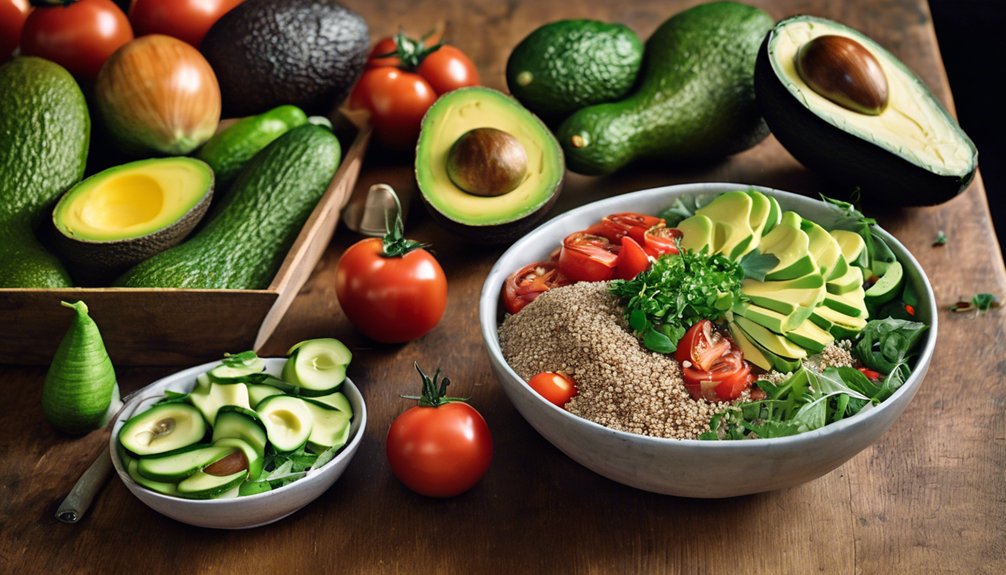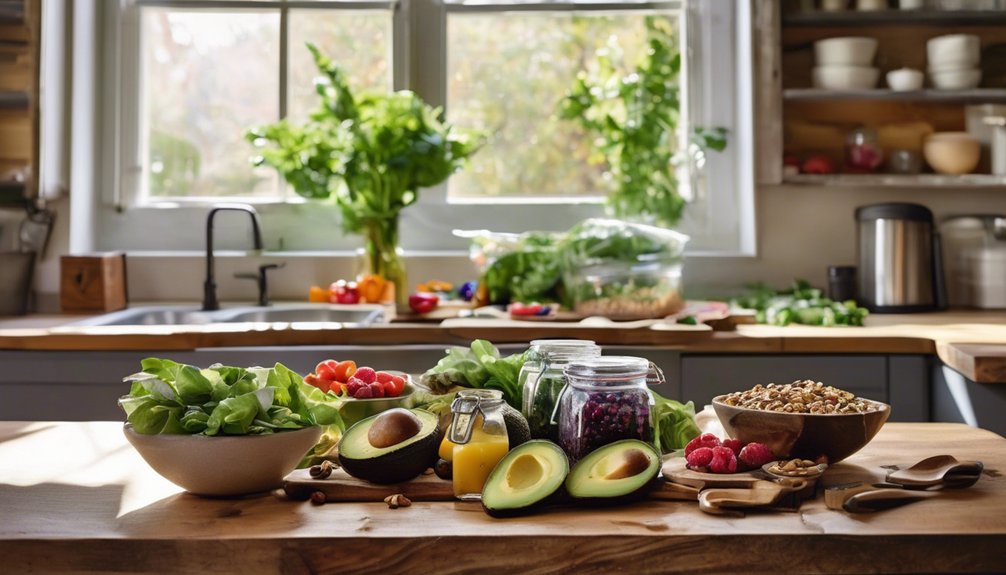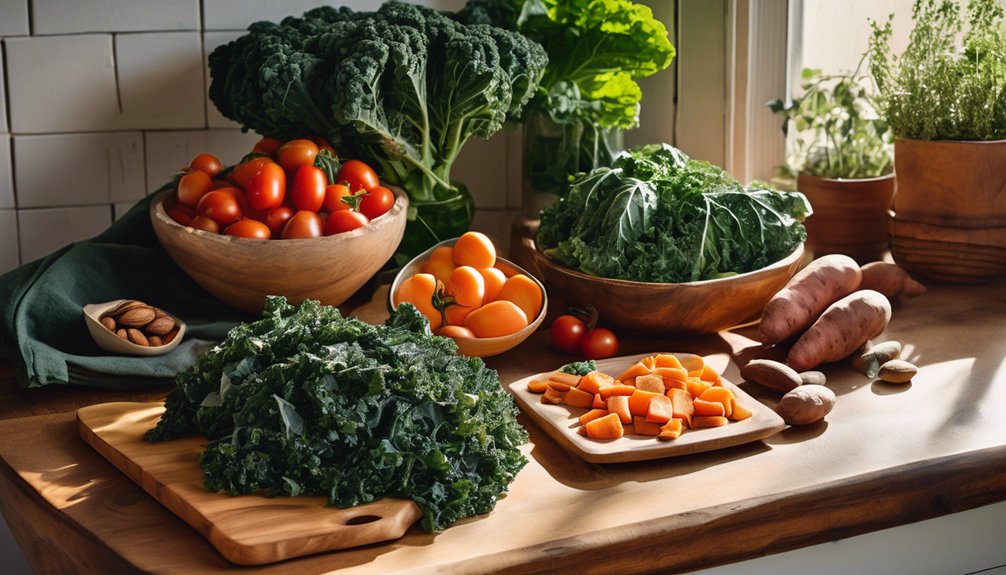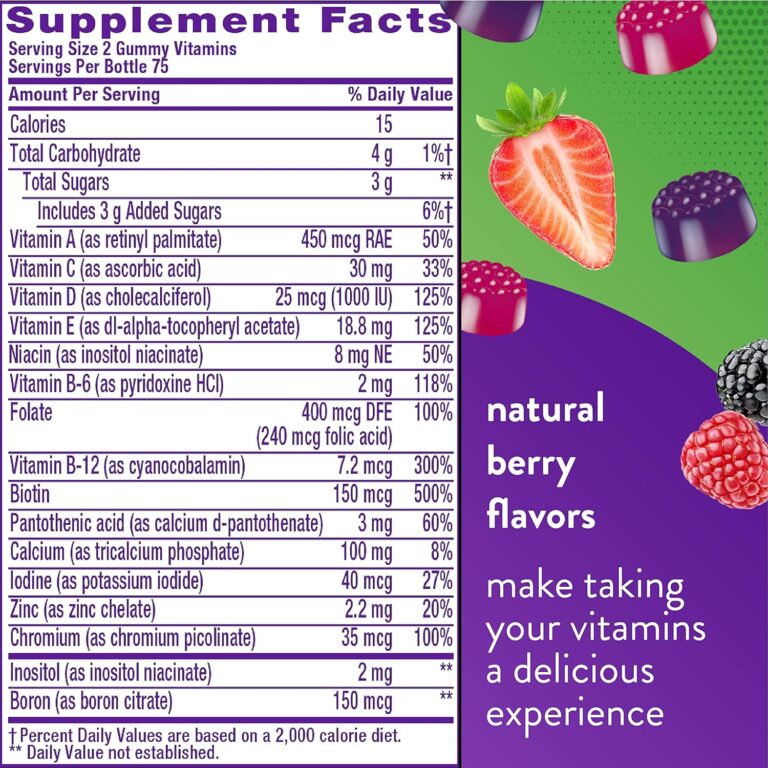Lose Belly Fat With Real Food
Losing belly fat with real food means choosing whole, nutrient-dense ingredients, prioritizing lean proteins, and filling your plate with vibrant vegetables. By incorporating fiber-rich foods and healthy fats, you can effectively manage your appetite and support your metabolism. But what specific nutrients should you focus on? And how can meal planning enhance your success? Understanding these elements can make all the difference in your journey toward a flatter stomach.
Key Takeaways
- Incorporate whole foods like colorful vegetables and lean proteins to promote satiety and reduce belly fat effectively.
- Focus on high-fiber foods to aid digestion and enhance feelings of fullness, supporting weight loss.
- Include healthy fats that help regulate hormones related to fat storage, facilitating belly fat reduction.
- Plan meals around nutrient-dense options to stabilize blood sugar levels and curb cravings for unhealthy foods.
- Practice portion control and meal timing to maximize fat loss results while enjoying delicious real food recipes.
Understanding Belly Fat and Its Health Risks
While you might think of belly fat as just an aesthetic issue, it poses significant health risks that you shouldn't overlook.
Visceral fat, the type that surrounds your organs, can lead to obesity and metabolic syndrome. Stress factors and hormonal imbalances often play a role in accumulating this fat, making it important to address them.
Your dietary habits also significantly affect your body composition; poor nutrition can contribute to insulin resistance, which in turn makes it harder to lose weight.
Additionally, some individuals may have a genetic predisposition to store fat in their midsection.
Recognizing these causes is crucial for your health journey, as tackling belly fat isn't just about looks—it's about enhancing your overall well-being.
The Power of Whole Foods for Weight Loss
When you focus on incorporating whole foods into your diet, you tap into a powerful strategy for weight loss that goes beyond mere calorie counting.
Whole food benefits are abundant, offering nutrient density that fuels your body and keeps you satisfied longer. By choosing whole foods, you're not only nourishing yourself but also making a lasting change in your eating habits.
Imagine filling your plate with:
- Colorful vegetables like kale and bell peppers
- Juicy fruits such as berries and apples
- Whole grains like quinoa and brown rice
- Lean proteins, including chicken and legumes
These foods help regulate your appetite and stabilize your blood sugar, making it easier to shed those stubborn pounds.
Embrace the power of whole foods, and watch your belly fat disappear!
Key Nutrients That Help Burn Belly Fat
To effectively burn belly fat, it's essential to focus on key nutrients that support your metabolism and promote fat loss. Prioritizing protein sources like lean meats and legumes helps you build muscle, which in turn boosts your metabolism. Incorporating fiber-rich foods aids digestion and keeps you fuller longer. Healthy fats from avocados and nuts can help regulate hormones related to fat storage. Antioxidant-rich foods, such as berries, combat inflammation and support overall health. Remember to practice portion control and pay attention to food timing for optimal results. Here's a quick reference table to help you:
| Nutrient | Benefits |
|---|---|
| Protein Sources | Builds muscle, boosts metabolism |
| Fiber Benefits | Aids digestion, promotes fullness |
| Healthy Fats | Regulates hormones |
| Antioxidant Rich Foods | Combats inflammation |
| Metabolism Boosters | Enhances fat burning |
Delicious Real Food Recipes for Fat Loss
Incorporating the right nutrients into your diet sets the foundation for effective fat loss, but how you prepare and enjoy those ingredients can make a significant difference too.
Here are some delicious real food recipes to help you on your journey:
- Healthy breakfast: A spinach and mushroom omelet topped with avocado, providing protein and healthy fats.
- Satisfying snacks: Greek yogurt mixed with berries and a sprinkle of nuts, delivering a perfect balance of sweetness and crunch.
- Lunch option: Quinoa salad with cherry tomatoes, cucumber, and a drizzle of olive oil, keeping you full and energized.
- Dinner delight: Grilled salmon with asparagus and sweet potatoes, rich in omega-3s and fiber.
These recipes not only taste great but also support your fat loss goals. Enjoy every bite!
Meal Planning Tips for Sustainable Weight Management
Meal planning can be a game-changer for achieving sustainable weight management, as it helps you stay organized and make healthier choices.
Start by dedicating a couple of hours each week for meal prep. Choose recipes that align with your goals and create a shopping list to streamline grocery shopping.
Focus on whole foods, like fresh fruits, vegetables, lean proteins, and whole grains, which will keep you full and satisfied.
Batch-cook meals in advance and store them in portioned containers to make weekdays easier.
Don't forget to mix things up to avoid monotony; variety keeps it exciting.
How to Build a Balanced Plate for Optimal Results
Building a balanced plate is key to maximizing your weight management efforts and supporting overall health.
By focusing on balanced portions, you can nourish your body while enjoying every bite. Practice mindful eating to savor flavors and recognize hunger cues.
Here's how to create your ideal plate:
- Fill half your plate with colorful vegetables: Think vibrant greens, reds, and yellows for essential nutrients.
- Include a quarter of lean protein: Opt for chicken, fish, or plant-based sources to keep you full.
- Add a quarter of whole grains: Choose quinoa, brown rice, or whole-grain pasta for sustained energy.
- Don't forget healthy fats: Incorporate avocados, nuts, or olive oil to enhance flavor and satiety.
This balanced approach can lead to optimal results!
The Role of Hydration in Losing Belly Fat
While you might focus on food choices to lose belly fat, staying hydrated is equally important for your weight loss journey. Proper hydration boosts metabolism, reduces cravings, and helps your body function optimally. Here's a quick look at hydration benefits to keep in mind:
| Hydration Benefit | Impact on Weight Loss | Suggested Water Intake |
|---|---|---|
| Reduces Appetite | Fewer calories consumed | 8-10 cups daily |
| Boosts Metabolism | Increased calorie burn | 1 cup before meals |
| Improves Digestion | Enhanced nutrient absorption | 1-2 cups during meals |
| Aids in Detoxification | Eliminates waste effectively | 1 cup upon waking |
| Enhances Performance | Better workouts, more energy | 1-2 cups post-exercise |
Make sure you prioritize your water intake; it's a simple yet powerful tool in your journey.
Staying Motivated on Your Journey to a Flat Stomach
Staying hydrated is just one part of your journey toward a flat stomach, but maintaining motivation throughout this process is equally important.
Setting clear goals helps you stay focused. Remember to celebrate small victories with positive reinforcement.
Here are some practical tips to keep your spirits high:
- Visualize your ideal stomach every day.
- Keep a journal to track your progress and reflect on your journey.
- Surround yourself with supportive friends or groups who share the same goals.
- Treat yourself to healthy meals that excite your taste buds.
Frequently Asked Questions
Can Stress Influence Belly Fat Accumulation?
Yes, stress can influence belly fat accumulation. When you're stressed, your body releases stress hormones, which may lead to emotional eating. This can result in fat storage around your abdomen, impacting your overall health.
How Does Sleep Impact Fat Loss in the Belly Area?
Imagine a garden thriving with love; it needs rest to flourish. Your sleep quality nurtures hormonal balance, crucial for fat loss. Prioritize restful nights, and watch your belly area transform, embracing the intimacy of self-care.
Are There Specific Foods to Avoid for Reducing Belly Fat?
To reduce belly fat, avoid high sugar intake and processed foods. These items can lead to weight gain and inflammation. Focus on whole, nutrient-rich foods instead, making healthier choices that support your overall wellness and goals.
How Long Does It Take to See Results From Dietary Changes?
How long can it take to see results from dietary changes? With dietary consistency and a boosted metabolic rate, you might notice changes in just a few weeks. Patience and commitment really make a difference!
Can Genetics Affect Belly Fat Distribution and Loss?
Yes, genetics can influence your fat distribution and loss. Your genetic predisposition may determine where your body stores fat, affecting how easily you lose belly fat. Understanding this helps you tailor your approach for better results.
Conclusion
As you embark on your journey to shed belly fat, think of your plate as a vibrant garden, flourishing with colorful vegetables, lean proteins, and healthy fats. Each meal you create nurtures your body and fuels your progress. By embracing whole foods, staying hydrated, and planning ahead, you cultivate a sustainable path toward lasting health. Remember, every small choice is a seed planted for a healthier you—watch it grow into the transformation you desire.











